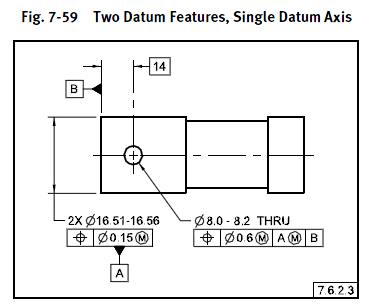mfg11eng11guy
Mechanical
I have a part that has opposing holes (nominally co-linear axis). holes are same size, separated by a large void. Pins get pressed into these holes and allow the part to pivot and I am only concerned about a projected tolerance zone. This is very similar to the example 7-44 and 7-45 given in ASME Y14.5-2009.
The shared axis of the holes acts as the primary datum, but I am unsure how to call this out.
Can I use position to do this using no datum structure? Can I only use form (Cylindricity) when establishing primary datum? If so, can I project a cylindricity zone?
Please advise.
The shared axis of the holes acts as the primary datum, but I am unsure how to call this out.
Can I use position to do this using no datum structure? Can I only use form (Cylindricity) when establishing primary datum? If so, can I project a cylindricity zone?
Please advise.

![[bigsmile] [bigsmile] [bigsmile]](/data/assets/smilies/bigsmile.gif)
